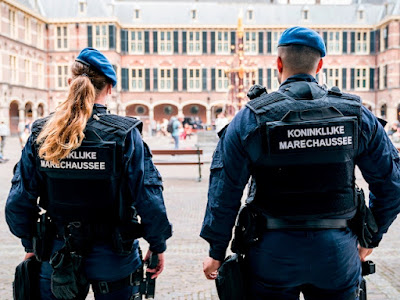The Royal Netherlands Marechaussee (Koninklijke Marechaussee, abbreviated to KMar) is the national gendarmerie force of the Kingdom of the Netherlands, performing military and civilian police duties.
It is also one of the two national police forces in the Netherlands, alongside the National Police, and is one of the four branches of the Netherlands Armed Forces.
The Corps de Maréchaussée was created by King William I to replace the French Gendarmerie on October 26, 1814. The word gendarmerie had gained a negative connotation, so William called the new force "marechaussée" (he forgot the first acute accent in the document). Maréchaussée is an alternate French word for gendarmerie.
In the French historical context, "Maréchaussée" had been the force's name under the Royal Ancien Regime, while the term "gendarmerie" had been adopted by the French Revolution - making the Royalist term preferable for the Dutch King.
After Kristallnacht in November 1938, the Dutch government officially closed its borders to any Jewish refugees. The Dutch Marechaussee border guards searched for them and returned any found to Germany, despite the horrors of Kristallnacht being well known.
In 1994, the national and municipal police forces were merged into 25 regional police forces and the Korps landelijke politiediensten (National Police Services Agency). The National Police transferred its airport police and security tasks (primarily Schiphol) to the Marechaussee.
The emblem of the Royal Netherlands Marechaussee is, as with many other gendarmerie forces, a flaming grenade. In the 17th century, a new weapon was introduced in Europe: the hand grenade. The soldiers who handled grenades were called grenadiers. They became an elite type of soldier in all European armies. In France, the grenade symbol was adopted by the gendarmerie, and this was imitated by similar forces throughout Europe.








No comments:
Post a Comment